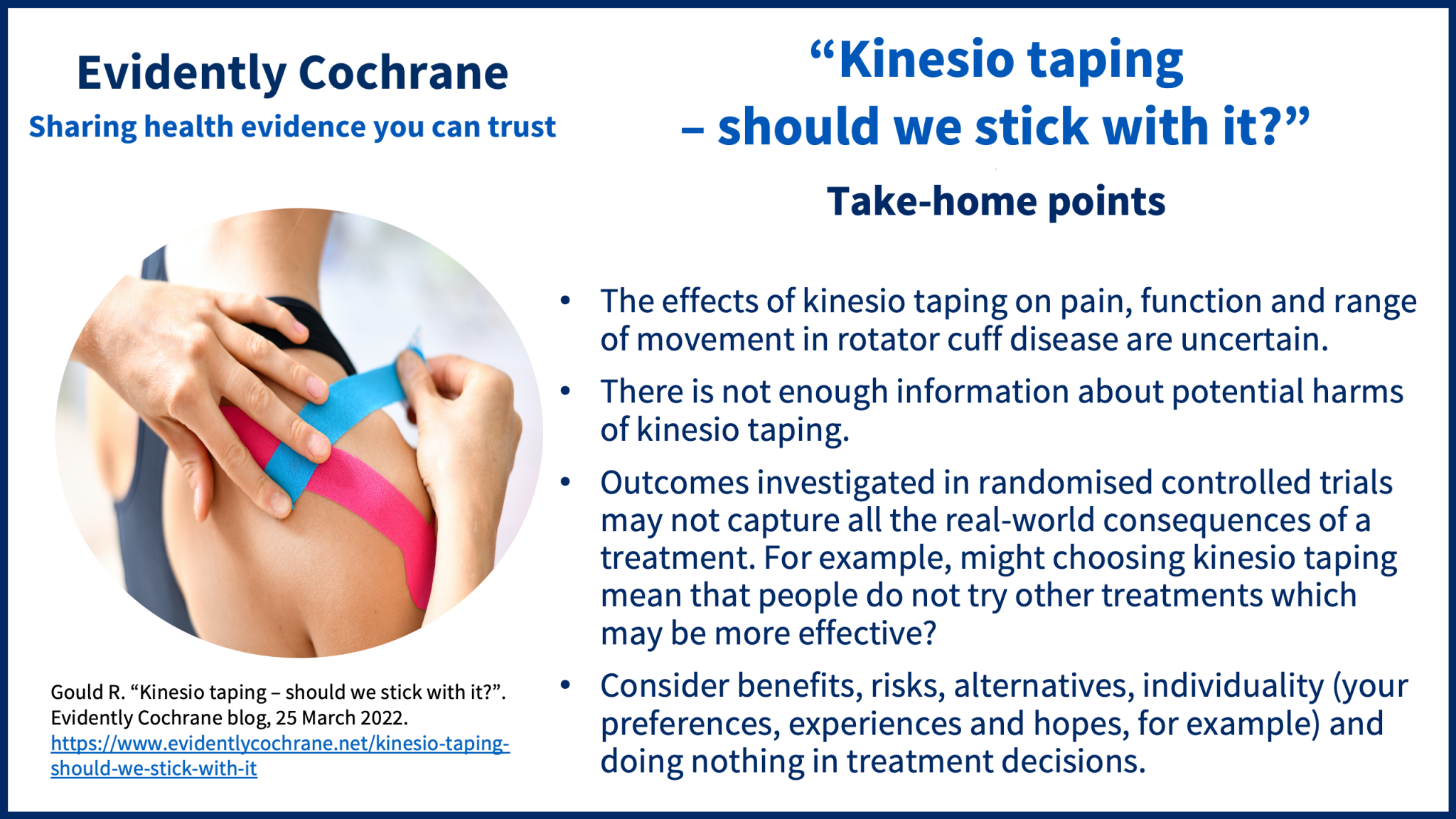In this blog for people with musculoskeletal problems, Dr Rebecca Gould, Cochrane UK Fellow and Sport and Exercise Medicine Registrar looks at the latest evidence for kinesio taping. Can some complementary treatments for musculoskeletal problems have unintended consequences?
Take-home points

Whether at the gym, the local park or on TV, you have probably seen someone exercising with brightly coloured tape, stuck over a muscle or joint. This is kinesio tape, an elastic tape that has been around since the 1970s but has gained popularity as a treatmentSomething done with the aim of improving health or relieving suffering. For example, medicines, surgery, psychological and physical therapies, diet and exercise changes. for various musculoskeletal disorders in the last decade or so. Despite its frequent use, uncertainty remains regarding its effectivenessThe ability of an intervention (for example a drug, surgery, or exercise) to produce a desired effect, such as reduce symptoms..
The rotator cuff is a group of muscles and tendons that surround the shoulder. Conditions that affect these structures are a common cause of shoulder pain in adults. They include shoulder impingement, rotator cuff tendinopathy (overuse of tendons), chronicA health condition marked by long duration, by frequent recurrence over a long time, and often by slowly progressing seriousness. For example, rheumatoid arthritis. (longstanding) rotator cuff tears and subacromial bursitis (inflammation of fluid filled pad found beneath tip of shoulder). ‘Rotator cuff disease’ has been proposed as an umbrella term to cover all of these conditions as they are thought to be related conditions with similar symptoms and treatments.
Kinesio taping for rotator cuff disease: what’s the evidence?
Cochrane recently published a review on kinesio taping for rotator cuff disease. In the Cochrane ReviewCochrane Reviews are systematic reviews. In systematic reviews we search for and summarize studies that answer a specific research question (e.g. is paracetamol effective and safe for treating back pain?). The studies are identified, assessed, and summarized by using a systematic and predefined approach. They inform recommendations for healthcare and research., kinesio taping was compared to sham (fake) taping in nine studies. In 14 studies kinesio taping, usually used alongside another treatment (co-intervention) such as exercise or physiotherapy, was compared to the co-intervention alone.
The authors concluded that kinesio taping had uncertain effects on pain, function and range of movement compared to sham taping or when added to other conservative (non-surgical) treatments such as physiotherapy or exercise. Compared to conservative treatments alone, the addition of kinesio tape may improve quality of life. However, this dataData is the information collected through research. was from a single small trial of 30 participants with short term follow-up (4 weeks). The authors noted that due to a lack of data they are uncertain if kinesio taping has any harms.
Might kinesio taping have any harms?
Despite the uncertain effects of kinesio taping, if a person with shoulder pain was thinking of trying it and asked my opinion, I would usually reply that the evidence is uncertain, but it is unlikely to cause harm (other than to their wallets perhaps). So, it would be an option to try for a short period of time to see if it worked for them. However, a recent discussion with colleagues in the Cochrane UK office has got me thinking about whether this approach could have unintended consequences.
Exercise therapy is considered the first-line treatment for rotator cuff disease, but requires effort and patience – exercises should be done regularly and take time (weeks to months) to have an effect. Does the availability of passive “quick-fixes”, like kinesio tape, affect people’s treatment preferences? In real-life, how many people would choose to try kinesio tape rather than embark on an exercise programme? These types of outcomesOutcomes are measures of health (for example quality of life, pain, blood sugar levels) that can be used to assess the effectiveness and safety of a treatment or other intervention (for example a drug, surgery, or exercise). In research, the outcomes considered most important are ‘primary outcomes’ and those considered less important are ‘secondary outcomes’. are not typically included in interventional trialsClinical trials are research studies involving people who use healthcare services. They often compare a new or different treatment with the best treatment currently available. This is to test whether the new or different treatment is safe, effective and any better than what is currently used. No matter how promising a new treatment may appear during tests in a laboratory, it must go through clinical trials before its benefits and risks can really be known. but are important to consider.
Qualitative studies may be helpful here in exploring people’s experiences, thoughts, and behaviour. A study of 30 people attending physiotherapy for back, neck or shoulder pain found that they wanted to be involved in decisions and felt trust in their physiotherapist was important. Some people preferred active treatment, such as exercise or advice on managing the conditions themselves. Others preferred passive treatment such as acupuncture or massage. Previous experiences and the media were the key influencers on their preferred treatment decision.
Treatment preferences are important for people and health professionals to consider when making decisions together on planned treatments. A meta-analysis of 27 studies that looked at the effect of treatment preference in randomisedRandomization is the process of randomly dividing into groups the people taking part in a trial. One group (the intervention group) will be given the intervention being tested (for example a drug, surgery, or exercise) and compared with a group which does not receive the intervention (the control group). controlled trialsA trial in which a group (the ‘intervention group’) is given a intervention being tested (for example a drug, surgery, or exercise) is compared with a group which does not receive the intervention (the ‘control group’)., across a range of health conditions, found that people who were allocated their preferred treatment interventionA treatment, procedure or programme of health care that has the potential to change the course of events of a healthcare condition. Examples include a drug, surgery, exercise or counselling. , of the options available as part of the studyAn investigation of a healthcare problem. There are different types of studies used to answer research questions, for example randomised controlled trials or observational studies., were more likely to have a better outcome.
Treatments don’t have to be given in isolation and kinesio taping could be used alongside exercise if there is a preference. However, could this have unintended consequences? Does kinesio tape act as a reminder that there is a pain or an issue and lead to worry, or a loss of trust in the body? Would people start using kinesio tape for other things such as minor aches and pains associated with exercise, such as delayed onset muscle soreness. Does this over-medicalise these normal sensations?
When making a treatment choice, think BRAIN!
For people making any treatment choice it can be helpful to think BRAIN, considering:
- Benefits
- Risks
- Alternative treatment options
- Individuality – Lucy Pollock (2021) explains this is what makes decisions easier and why we don’t all make the same decision – it can include our knowledge of what’s gone before, our hope for what is next, and our lived experience
- and, what if I do Nothing?
For me, next time I am asked about kinesio taping (or any other treatment decisions for that matter) I will also use ‘think ‘BRAIN’ and consider possible unintended consequences to make sure the person I am speaking to understands their choices.
Join in the conversation on Twitter with @CochraneUK and @DrRebeccaGould or leave a comment on the blog.
Please note, we cannot give medical advice and do not publish comments that link to individual pages requesting donations or to commercial sites, or appear to endorse commercial products. We welcome diverse views and encourage discussion but we ask that comments are respectful and reserve the right to not publish any we consider offensive. Cochrane UK does not fact check – or endorse – readers’ comments, including any treatments mentioned.
Rebecca Gould has nothing to disclose.



[…] (2) Evidently Cochrane: Kinesio Taping (zdroj) […]
How often do you change the tape?
How often do you tape?
Hi Rebecca
I was surfing through the internet for a while just to get in-depth information about the topic you wrote about and it really helped me to know more about the harms one can get through kinesio tape, especially for shoulder pain. Keep sharing such blogs further as well. And kindly let me know how can I subscribe to the Newsletter. Thanks.
Hi, the newsletter sign-up is here the newsletter sign-up form is here: https://www.evidentlycochrane.net/newsletter/
Best wishes,
Sarah Chapman [Editor]